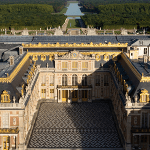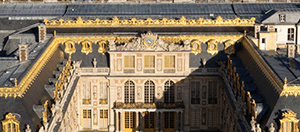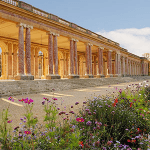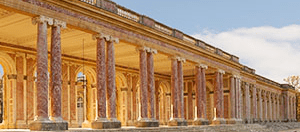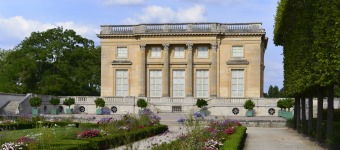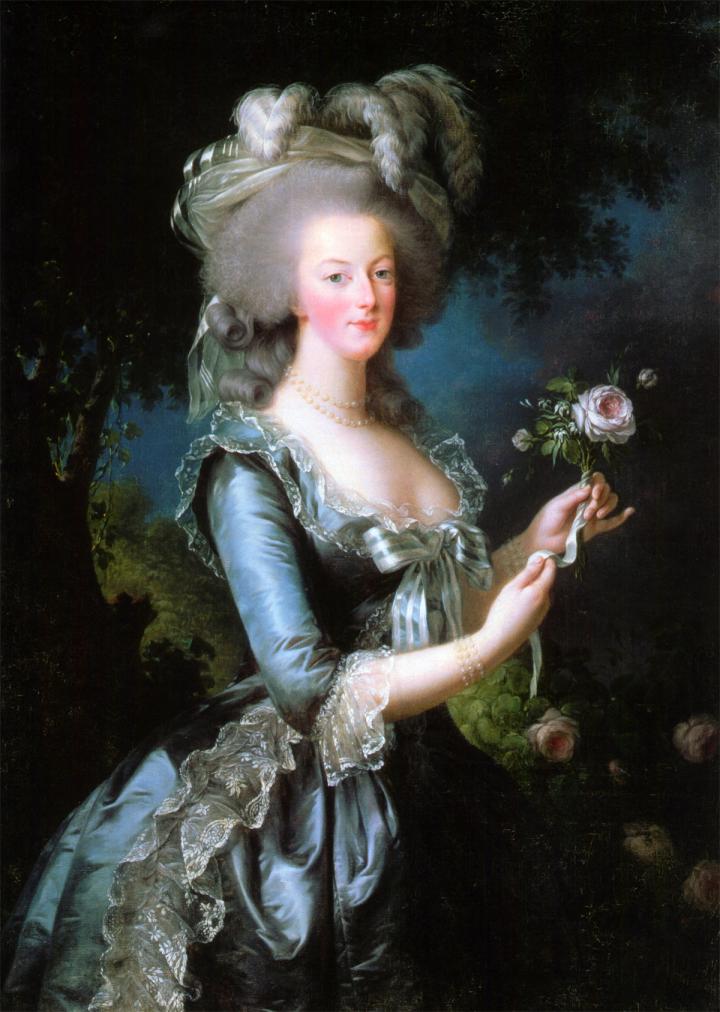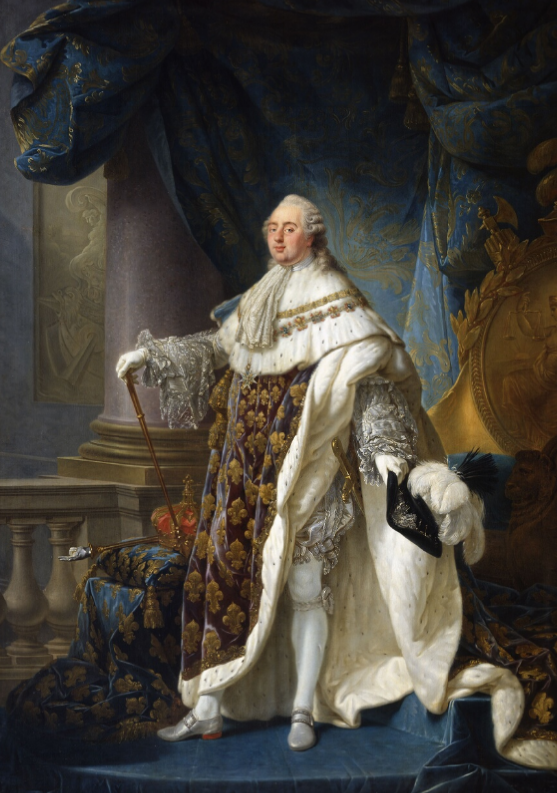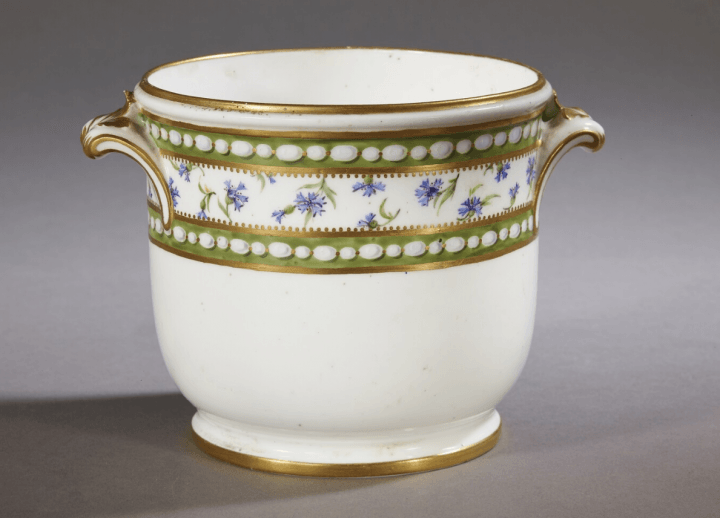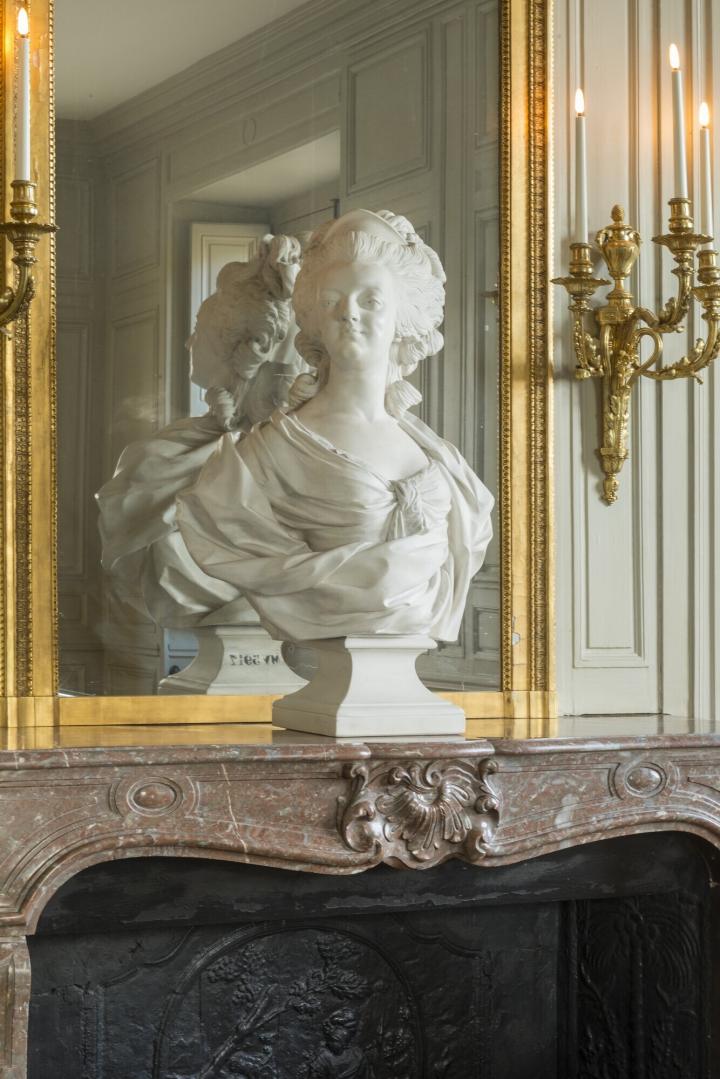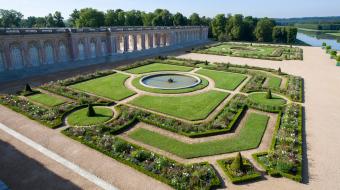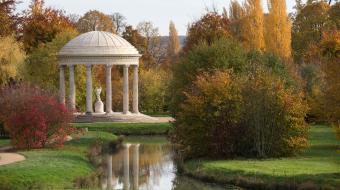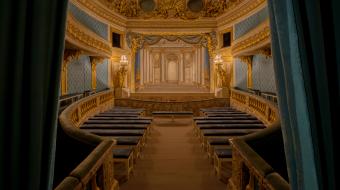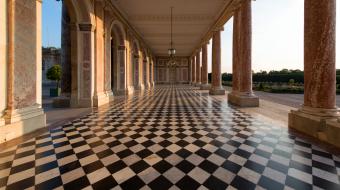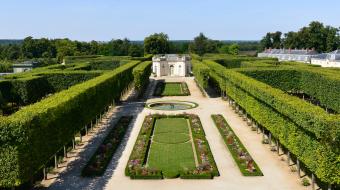History of the Site
Completed by Ange-Jacques Gabriel in 1768, the new palace on the Trianon estate was named the Petit Trianon to distinguish it from the existing Marble Trianon, which then became known as the Grand Trianon. It was here, in April 1774, that Louis XV experienced the first symptoms of smallpox, which would lead to his death a few days later and usher in the reign of Louis XVI and Marie-Antoinette. The new King Louis XVI gave the Petit Trianon as a gift to his wife, who quickly made it her own and ordered an extensive redesign of the external areas. Louis XV's botanical gardens were soon replaced by an Anglo-Oriental garden, which was more in keeping with the fashion of the day and which Marie-Antoinette was constantly adding to and embellishing.
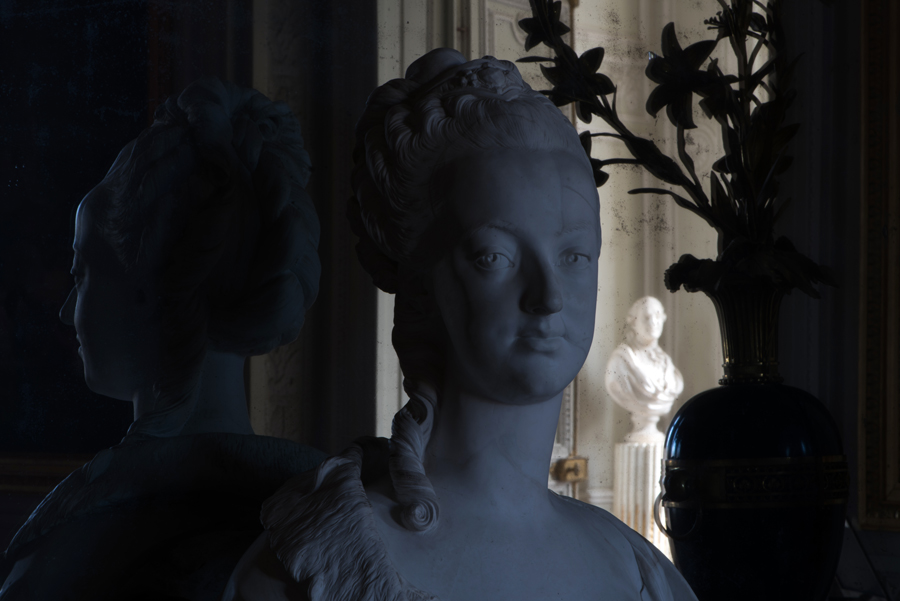
During the French Revolution, the Petit Trianon became a hostel for a time, while the gardens narrowly escaped being divided into separate allotments. Napoleon restored the palace and gardens to their former glory, first for his sister Pauline and later for the Empress Marie-Louise, his second wife. Later, the palace was handed over to the Duke of Orleans, eldest son of Louis-Philippe. Then, in 1867, the Empress Eugénie, wife of Napoleon III, converted the Petit Trianon into a museum dedicated to the memory of Marie-Antoinette. She even organised the first-ever exhibition there devoted to the former queen.
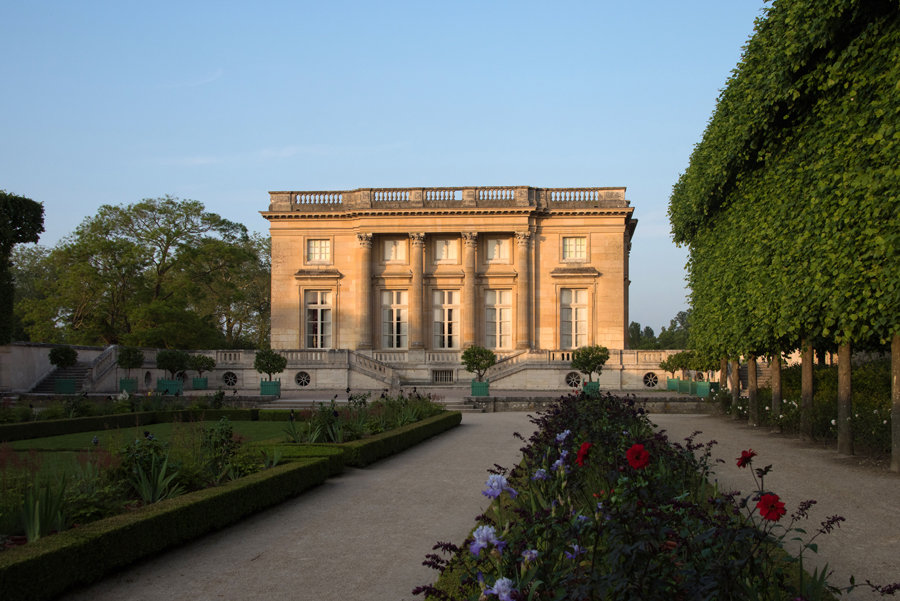
© THOMAS GARNIER
The palace is laid out in an extremely simple cube shape, with a flat roof surrounded by a balustrade. Gabriel avoided making his design seem too simple by varying the look of each of the façades of the palace. The south façade, overlooking the Honour Courtyard, is simply adorned with four pilasters accentuating the slight projection of the three central bays; the north façade echoes this arrangement but over one less floor, on account of the difference in the level of the garden; the east façade, which once overlooked Louis XV’s vegetable garden, is the most restrained; the west façade, however, which looks out over the French Gardens, is far more detailed and cleverly accentuated by a slight projection framed by four majestic Corinthian columns and by the subtle choreography of steps and terraces leading down to the garden. The proportions of its composition make the Petit Trianon a masterpiece of harmony and elegance.
Inside, the first two floors are laid out around the vast staircase. Since the palace is built on a slope, the first-floor reception rooms open out directly onto the gardens. Marie-Antoinette’s apartment looks out over the English Gardens and the Love Monument.
The palace was completely restored a few years ago and may now be visited at your leisure or as part of a guided tour.
The Ground Floor
Honour Courtyard
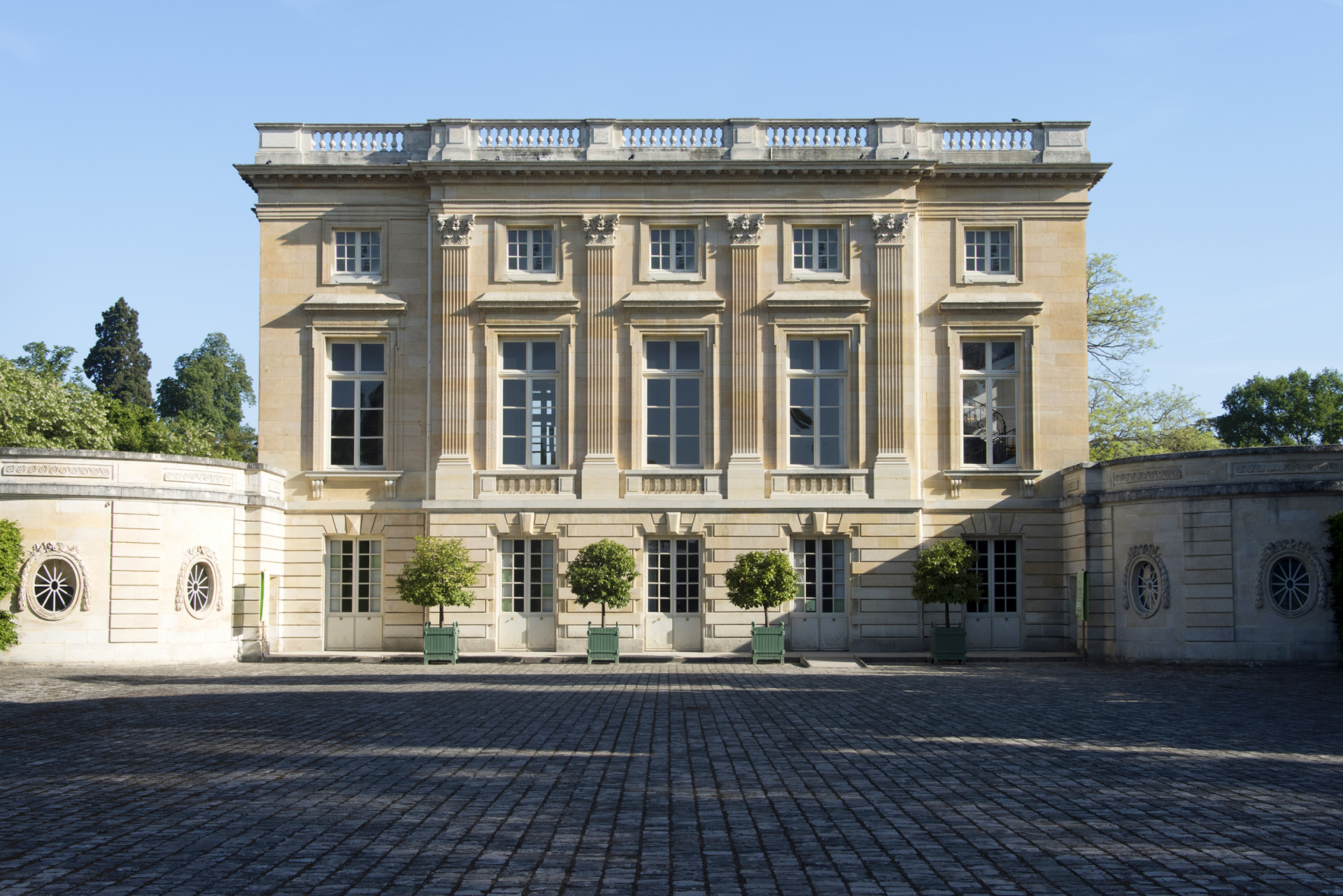
© THOMAS GARNIER
At the end of a long walkway bordered by Lombardy poplars there is a gate, flanked by two small pavilions, which opens into a vast courtyard lined on all sides by walls that conceal service passageways and the gardens. This highly mineral aspect gives the palace the air of a private mansion.
Honour Staircase
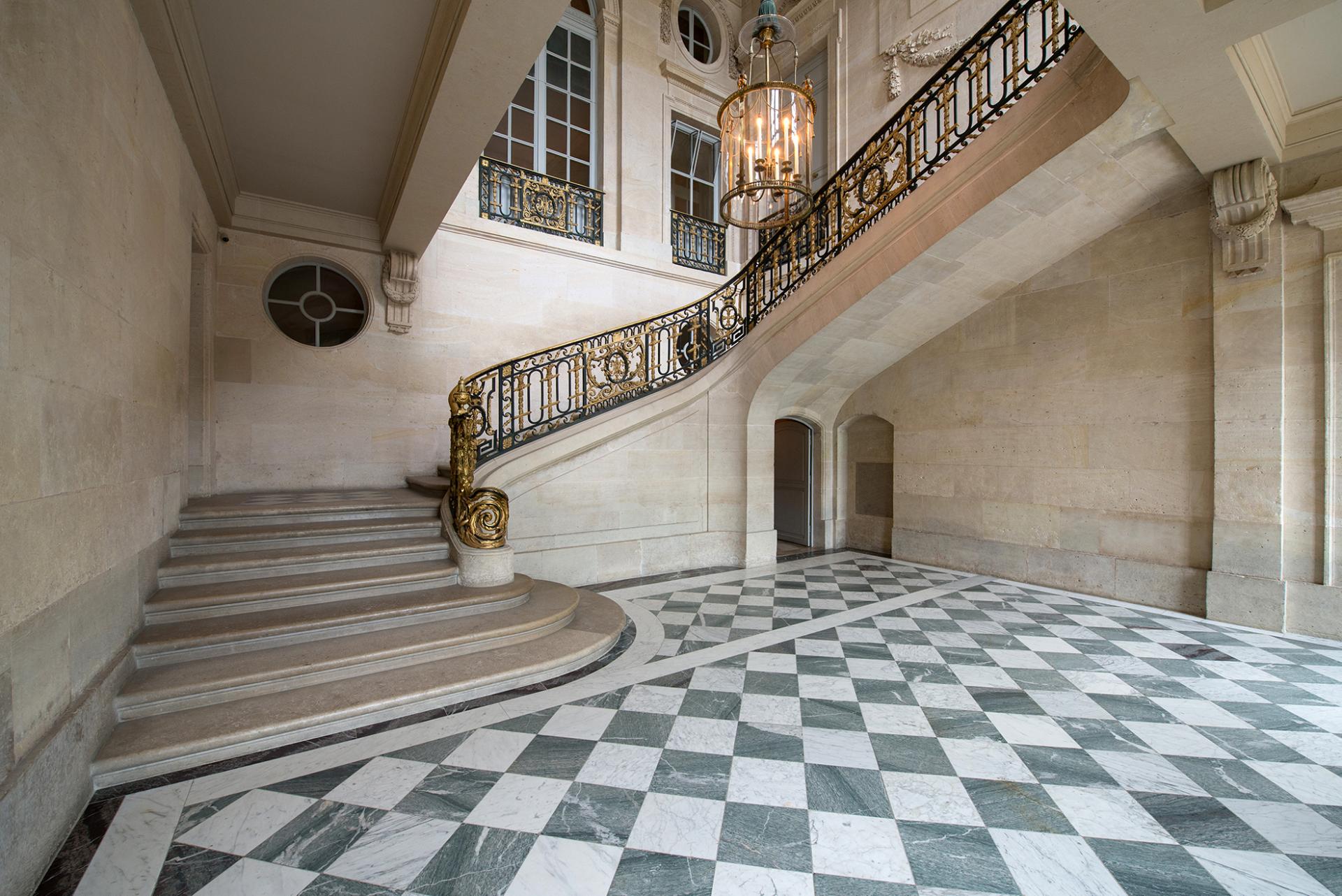
Honour staircase
© THOMAS GARNIER
The sculpted décor of the enormous staircase at the heart of the building is decidedly restrained, complementing the perfect lines of the overall construction, which are accentuated by the abundant natural light streaming in through the three French windows and three casement windows on the upper level. The floor is a made from green and white marble. The banister of forged iron and gilded bronze, made by the metalworker François Brochois, bears the monogram of Marie-Antoinette, which replaced that of Louis XV.
The Billiards Room
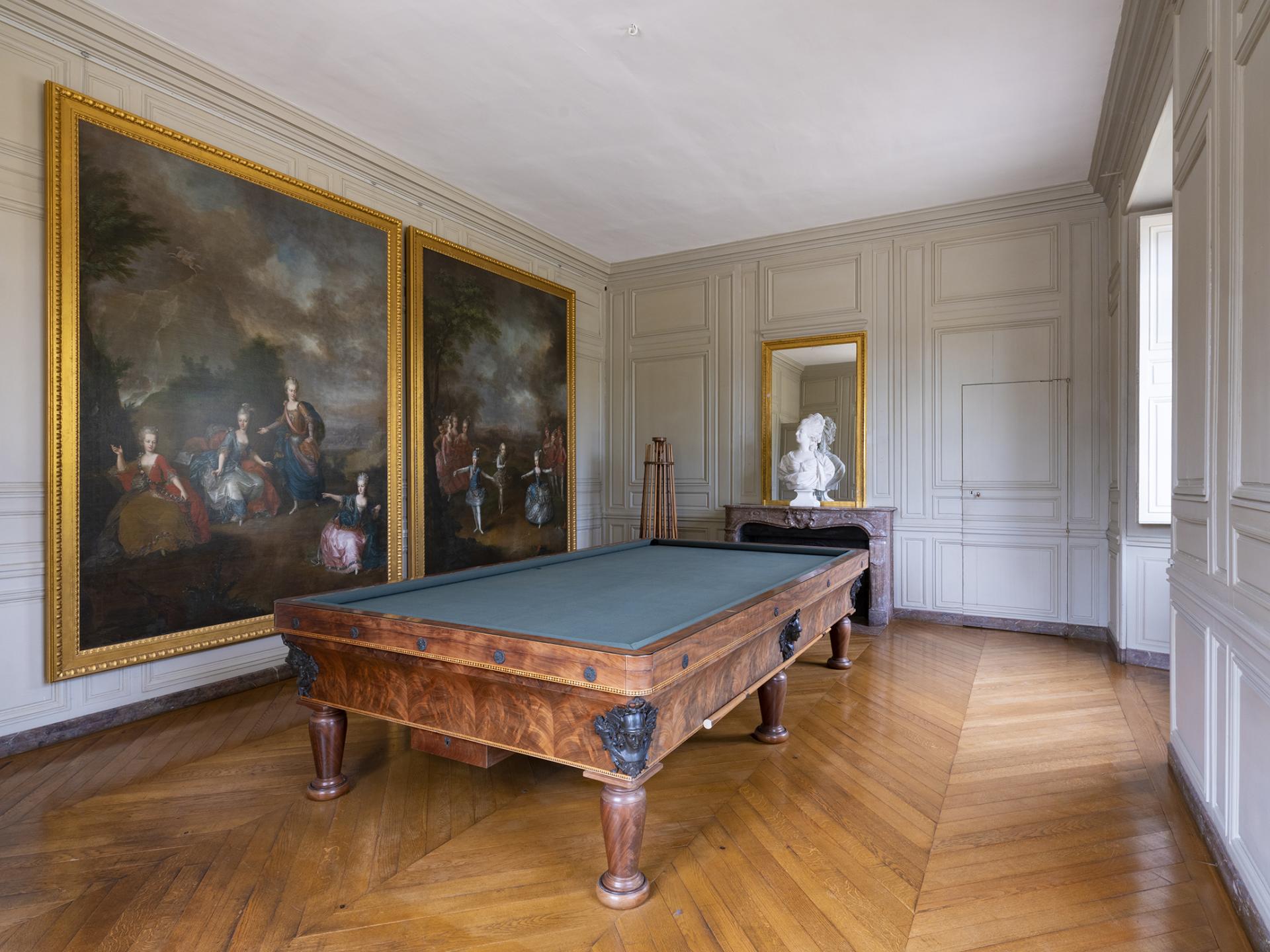
Billards Room
© THOMAS GARNIER
During the reign of Louis XV, this plain, wood-panelled room featured an ornate billiards table, but Marie-Antoinette had this moved to the first floor in 1784 and replaced with an ordinary version for use by the guardsmen, whose room was situated on the other side of the hall. On the mantelpiece is a bust of the queen created by Louis-Simon Boizot. The original is now held in the Louvre. On the wall is one of the portraits of the queen painted by Élisabeth Vigée-Lebrun.
The Warming-up Room
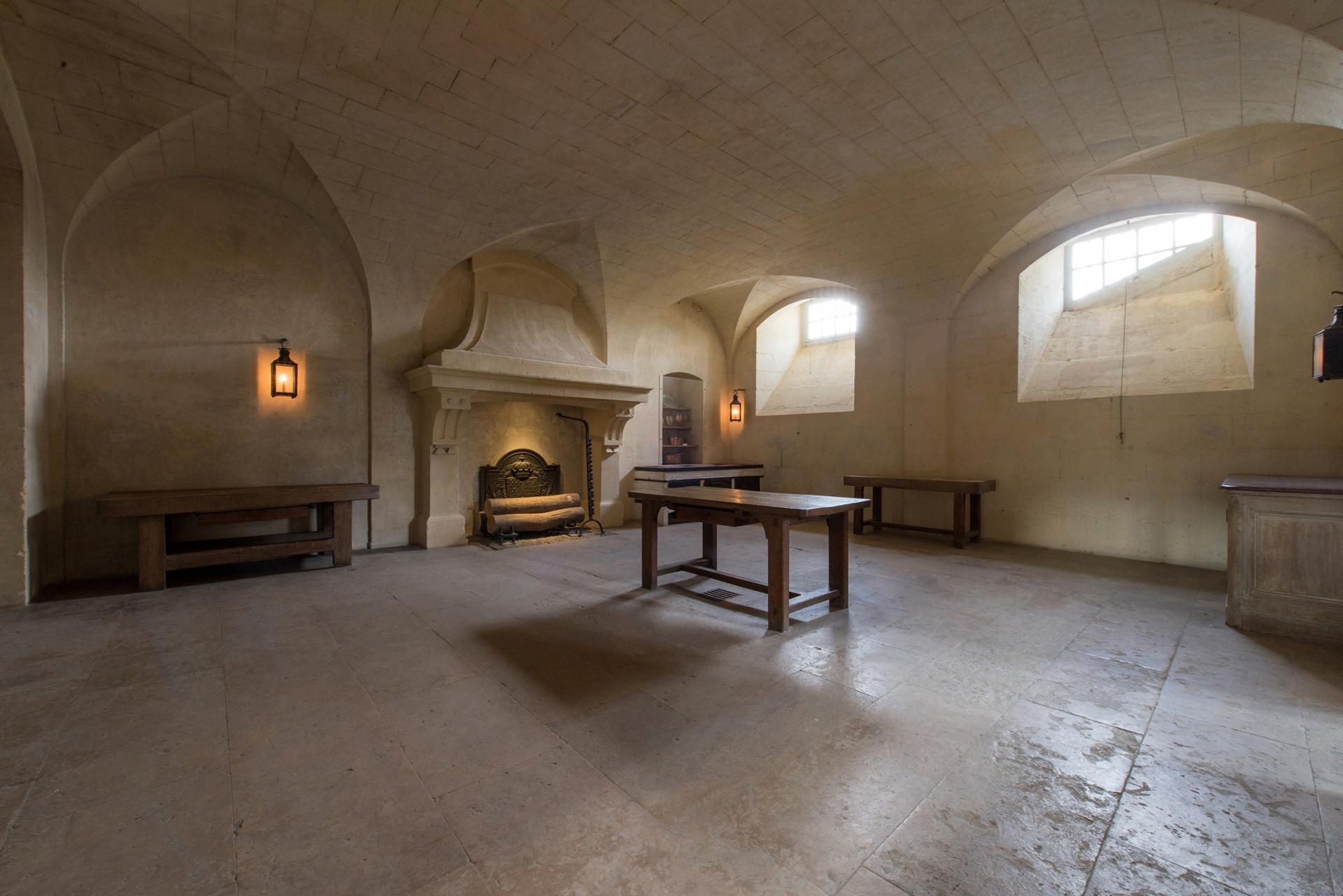
Warming-up Room
© THOMAS GARNIER
The warming-up room, which can be accessed from the hall, was used for warming up the food brought from the kitchens before it was served at the royal table. Not long after she arrived at the Petit Trianon, Marie-Antoinette had this room closed, because of the smells permeating her apartments from it. However, you can still see the impressive chimney hood that remains.
The fruit repositories and “flying tables”
Here is where dishes were prepared before being served in the dining rooms located above, on the first floor. Louis XV once wanted to equip the Petit Trianon with “flying” or retractable tables like those already in use at the Château de Choisy. The system, which was to be located below the dining room (the planned position for it can still be seen today), would have employed counterweights to raise fully set and decorated tables straight up to the first floor through openings that had been specially made in the floor and could be closed at will. However, the price demanded by the engineer Loriot to install it was so high that the king changed his mind.
The Silverware Room
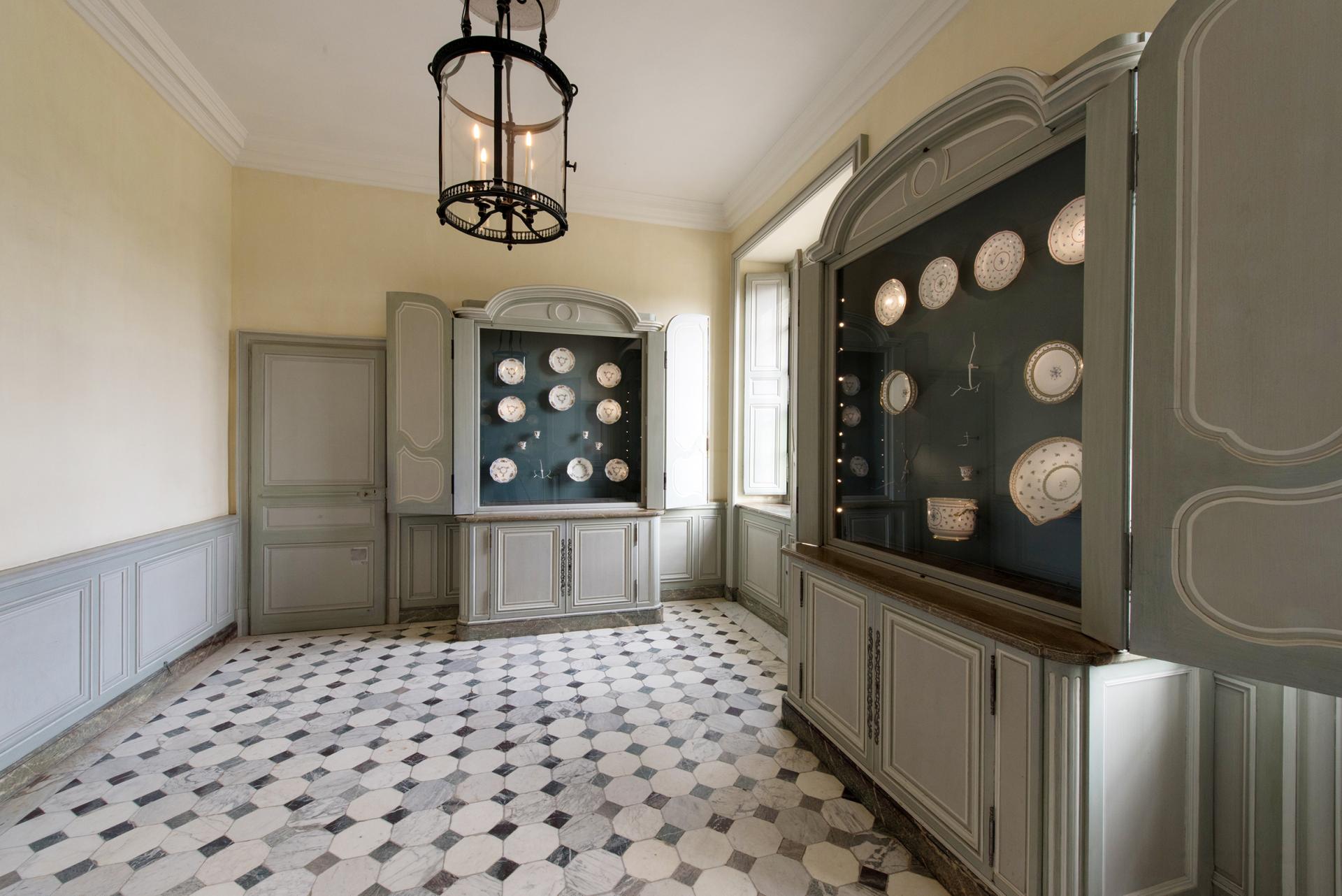
Silverware Room
© THOMAS GARNIER
This room behind the hall, with its chequered marble floor and large cabinets, was where the cutlery sets and porcelain dining services were kept. Marie-Antoinette, even though she preferred private dining, nevertheless appreciated luxury and elegance at her table. She ordered several services from the Sèvres manufactory. One of the most iconic is this one, featuring “pearls and cornflowers”, made in 1781 and comprising 295 pieces, including 120 plates.
The Chapel
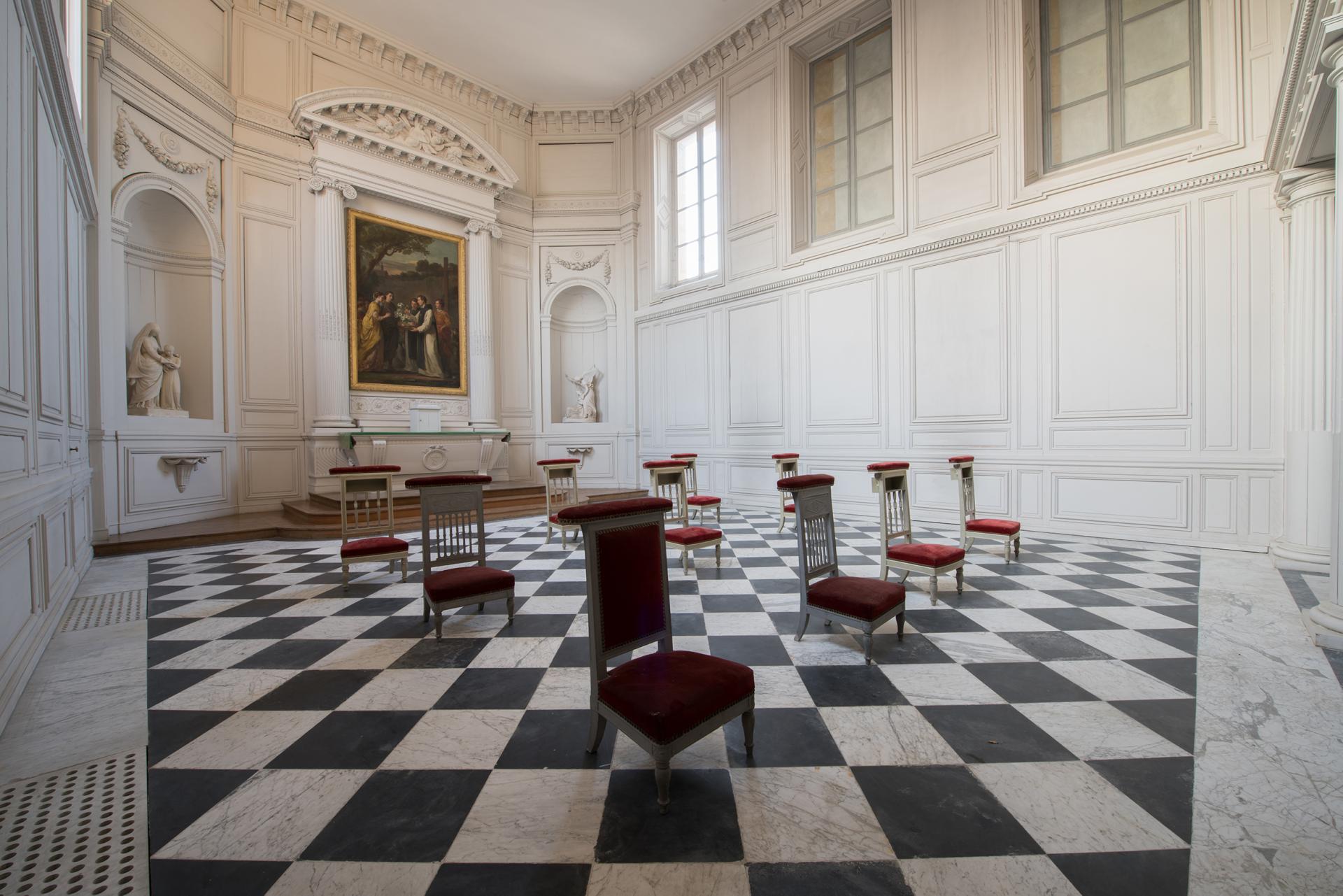
Chapel
© THOMAS GARNIER
The Petit Trianon chapel was built in 1772 by the architect Ange-Jacques Gabriel over two floors. Its décor is very simple; the room is lit by high windows, two of which are merely painted on, due to the proximity of the servants’ quarters, which adjoin the chapel. The altar is flanked by two columns and decorated with a radiant halo sculpted by Joseph Prévôt. Hanging above it is a painting by Joseph Marie Vien produced especially for this space and installed in 1776. It depicts Saint Thibault of Marly offering Saint Louis and his wife, Marguerite de Provence, a lily with eleven stems, symbolising the posterity of their line.
Facing the altar is a gallery, which can be accessed by stairs from the servants’ quarters or directly from the French Gardens.
The first floor
Buffets Antechamber or Room
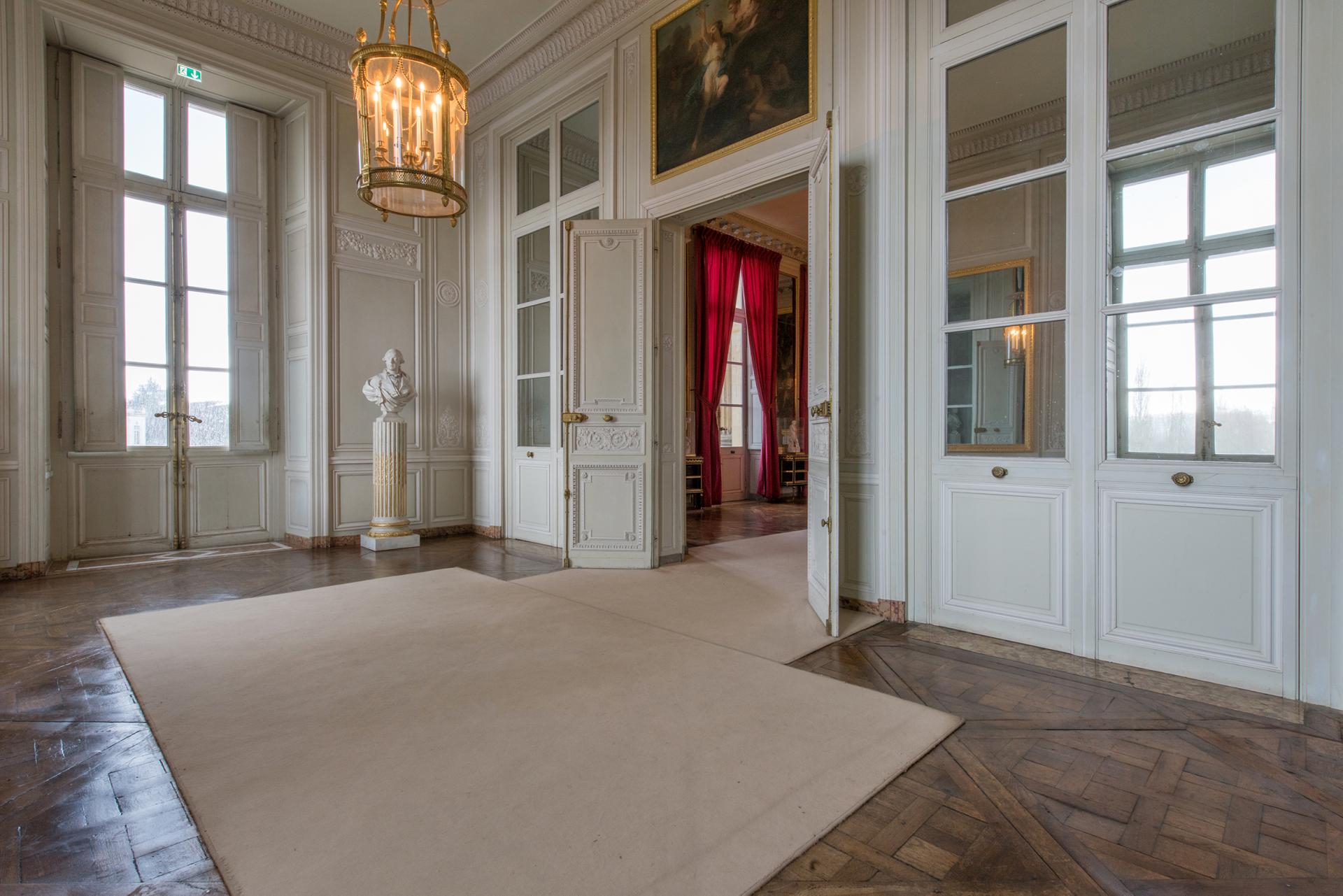
Buffets Antechamber or Room
© THOMAS GARNIER
The antechamber, which is also known as the “buffets room” or “stoves room”, is the first room you enter on arrival on this floor. During the reign of Louis XV, it housed two stoves, one on either side of the door leading to the dining room, which were used to heat both rooms.
In keeping with Louis XV’s desire to combine the interior and the exterior at Trianon, the terrace and French Gardens can be accessed directly from this room. In the same vein, Marie-Antoinette decided to blur the line between inside and outside even more by having the small windowpanes replaced by large panes of glass, which were considered a luxury at the time.
Focus:
This room houses “Marie-Antoinette with a Rose”, by Élisabeth Vigée-Lebrun. This portrait – probably the most famous one of the queen – depicts the sovereign in modest and elegant attire. A previous version, which scandalised the members of Court, depicted the queen in the same pose but wearing a muslin “de Gaulle”-style dress and a straw hat – the type of clothing she liked to wear at the Petit Trianon.
The Main Dining Room
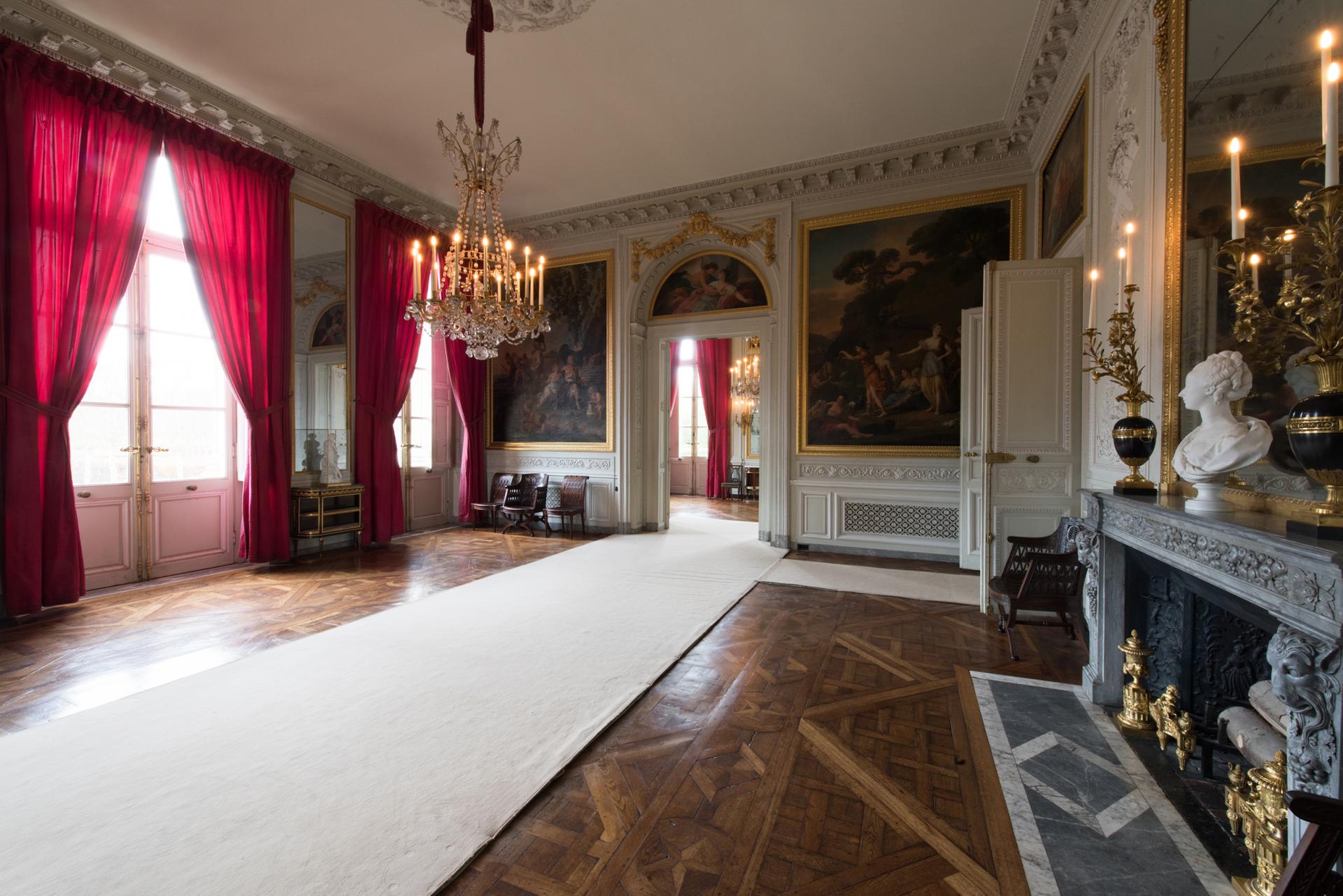
Main Dining Room
© THOMAS GARNIER
This grand dining room, where Louis XV dined for the first time on 11 September 1769, was able to accommodate 50 guests. Its discreetly luxurious décor is entirely dedicated to nature. The wood panelling, by Honoré Guibert, and the Turquin blue marble fireplace by Jacques-François Dropsy, are decorated with laurels and garlands of fruit and flowers.
The four large paintings celebrate the seasons and nature’s bounty: La Pêche (Fishing) by Doyen, La Moisson (The Harvest) by Lagrenée, Les Vendanges (Grape picking) by Hallé and La Chasse (The Hunt) by Vien. The mahogany chairs are from the dairy at the Château de Rambouillet. Designed by Hubert Robert in the Etruscan style, these remarkable pieces were made by Georges Jacob in 1787.
The Small Dining Room
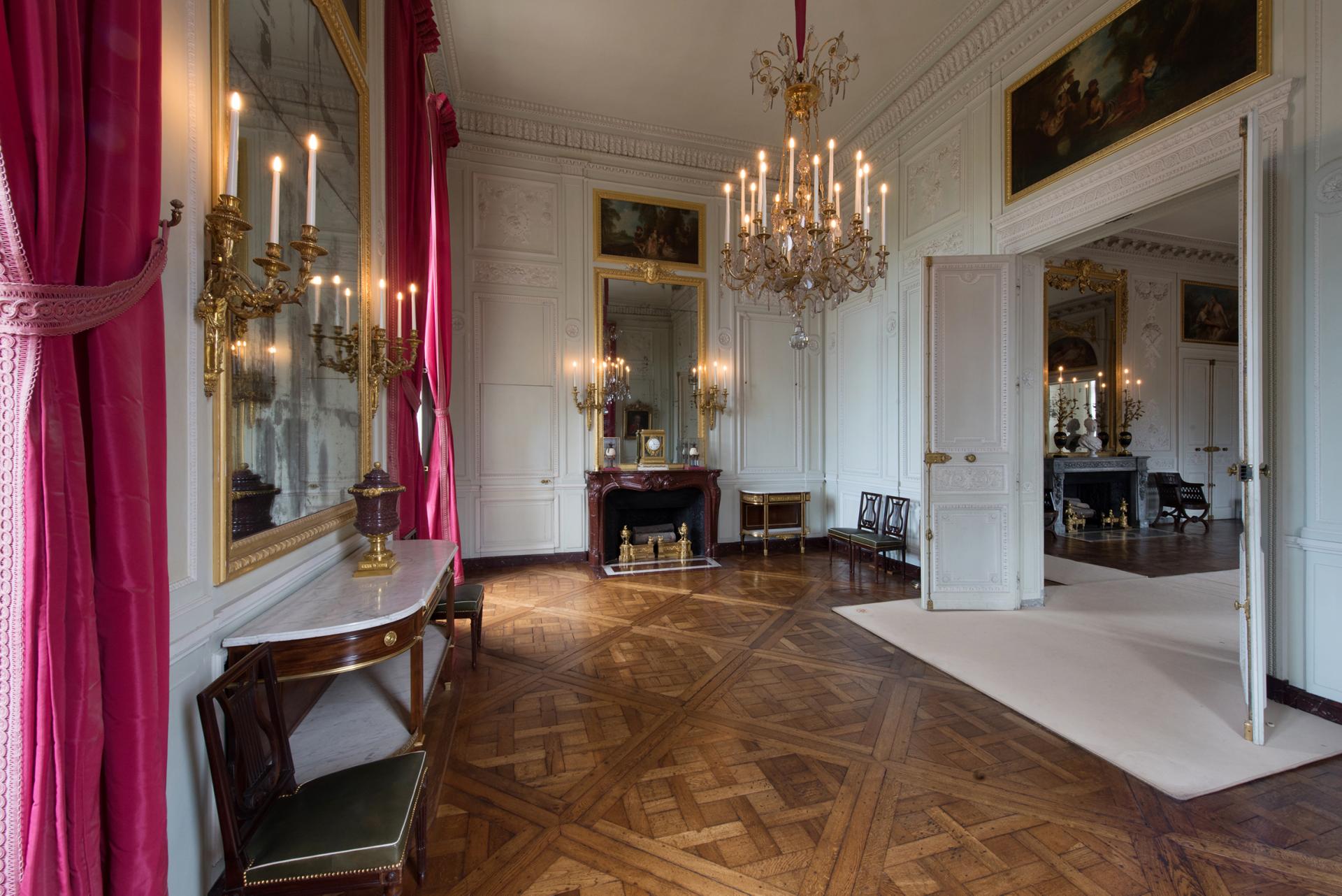
Small Dining Room
© THOMAS GARNIER
The Main Dining Room opens onto the Small Dining Room. More intimate than the former, the Small Dining Room was able to seat twenty guests. This is the room that Louis XV once had the idea of equipping with “flying tables” before changing his mind when he discovered how costly such an installation would be.
Later, Marie-Antoinette had Louis XV’s billiard table placed there.
The Reception Room
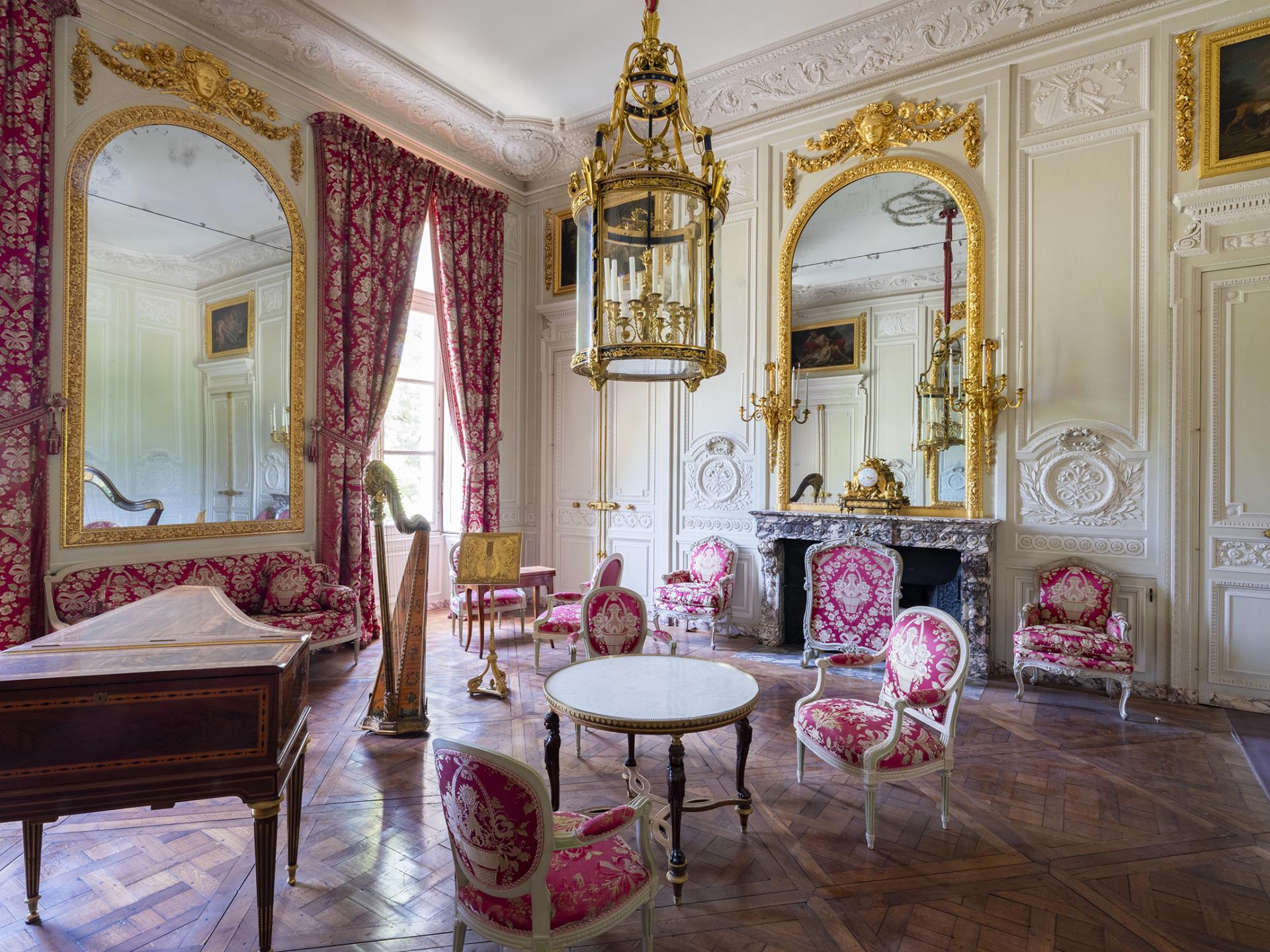
Reception Room
© THOMAS GARNIER
The main dining room provides access to the main room on this floor: the reception room. The sculpted décor here is highly intricate. The lower insets in the wainscoting are decorated with the monogram of Louis XV interlaced with a lily stem bearing three flowers and topped with roses. The spectacular light fitting, made from engraved bronze gilded in two-tone gold and partly lacquered, was commissioned by the queen in 1784 for this very room. Two instruments have been placed in the room today as examples of what the queen liked to play: a piano-forte by Taskin dating from 1790 (brought to Versailles during the reign of Louis-Philippe) and a harp (maker unknown) from 1780.
The Movable Mirrors Boudoir
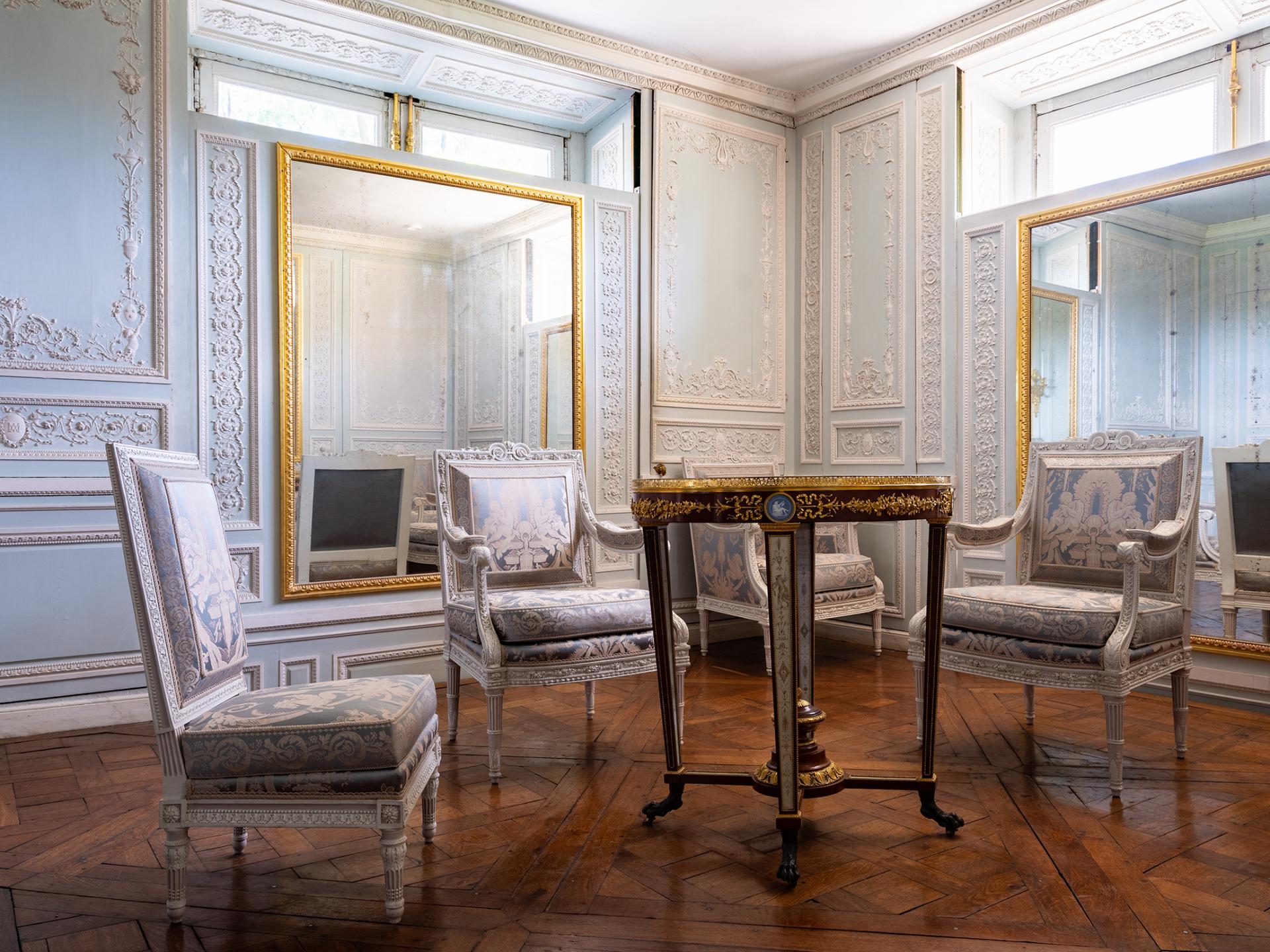
Movable Mirrors Boudoir
© THOMAS GARNIER
Formerly used by Louis XV, this room features a private staircase, which enabled the king to reach the mezzanine just above.
When Marie-Antoinette moved into the Petit Trianon in 1777, she had the staircase removed and turned this small corner room into a private place of sanctuary. It still features her exquisitely detailed wainscoting, as well as the wood panels and movable mirrors requested by the queen. A mechanism on the floor below could be used to raise or lower these panels, which, here, replace the shutters and, when raised, completely conceal the doorways. Louis XVI, in turn, copied this original system for his bedchamber at the Château de Saint-Cloud.
The Bedchamber
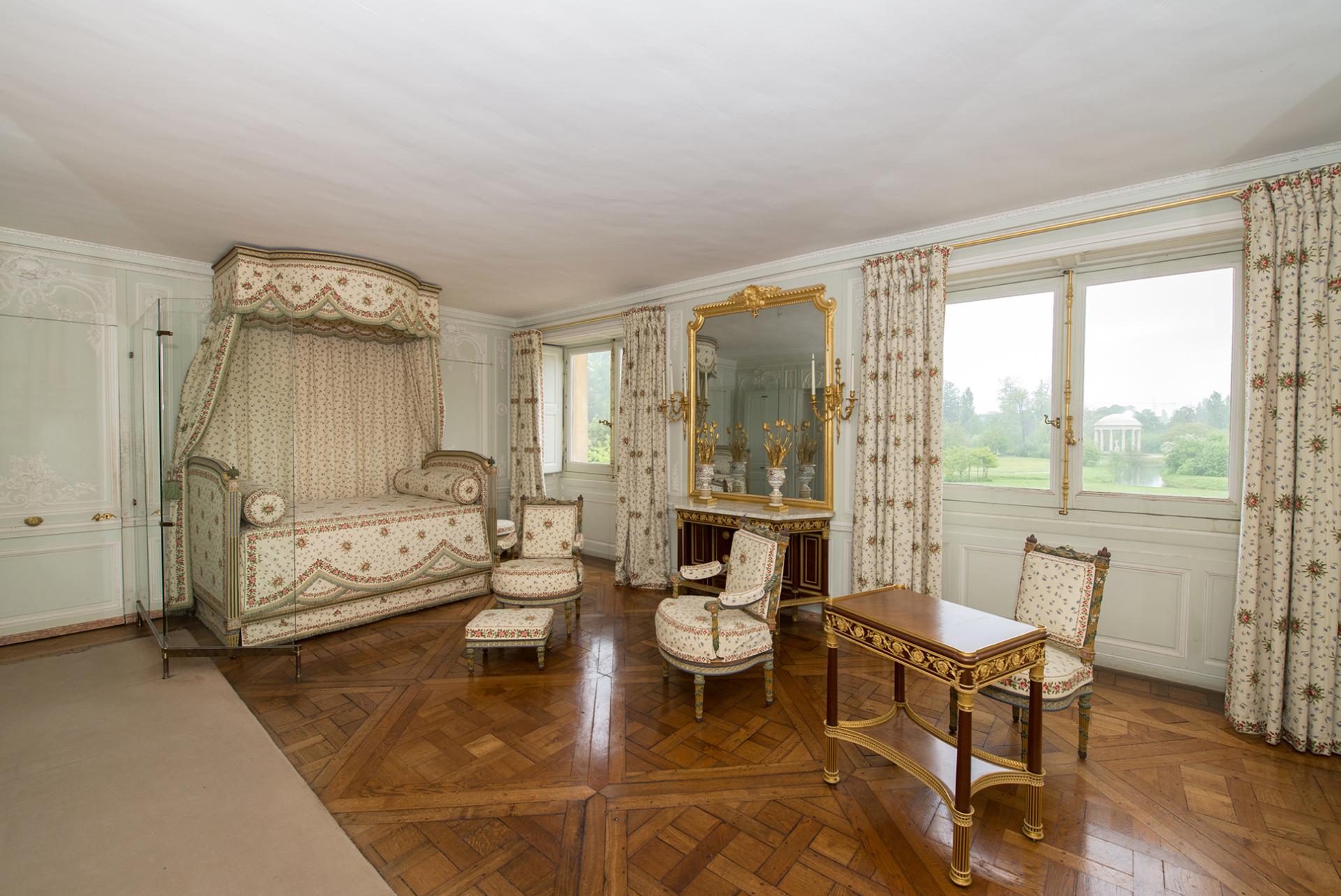
Bedchamber
© THOMAS GARNIER
Marie-Antoinette took over this bedroom, which had been Madame Du Barry’s.
The queen commissioned the ornamentalist and decorator Jean-Démosthène Dugourc to redesign it. The woodworker Georges Jacob was tasked with furnishing it with a so-called sheaf collection, decorated with sculpted wheat sheaves tied with ribbons, ivy and jasmine, lily of the valley and pine cones, representing the four seasons. These nature motifs emphasised the rural feel of the Petit Trianon.
The mezzanine
During Louis XV’s reign, the mezzanine, located above the Queen’s Apartment, was reserved for Madame Du Barry. Marie-Antoinette allocated it for the accommodation of her female servants: her lady-in-waiting and first lady-in-waiting.
The third room on the mezzanine, in the corner above the Movable Mirrors Boudoir, is where Louis XV’s private staircase emerged, the outline of the wood panelling of which was discovered beneath the old 19th-century painted wallpapers.
The Library

Library
© THOMAS GARNIER
The removal of Louis XV’s private staircase freed up this room, which, in 1780, was fitted out with large cabinets (reconstructed in 2008) and converted into a library by Richard Mique. The works were bound in marbled or stippled calfskin. The bookplates bore the queen’s arms and, on the back, the label CT (Château de Trianon) topped by the royal crown.
This room was used mainly by the queen’s reader, who would often come to look for a book at Marie-Antoinette’s request. It contained mainly literary and theatrical works, as well as some botany texts.
The attics
Ange-Jacques Gabriel had converted the attic into an apartment for Louis XV and a set of accommodation for the nobles in his entourage. The royal apartment, comprising an antechamber, a bedroom and a private chamber, was naturally reserved for Louis XVI, although he never actually slept there. It was most likely occupied by the king’s sister, Madame Élisabeth, whenever she stayed at Trianon. The rooms after the king’s apartment were recently redesigned to reflect the women who resided at the Petit Trianon. The rooms dedicated to Madame Élisabeth and Madame Royale are partly furnished with items from Trianon. On display in the following rooms is furniture from the private chamber and bedroom of the Empress Marie-Louise, which was reused by the Duchess of Orleans, furniture from whose boudoir has also been retained.
The King’s Bedchamber
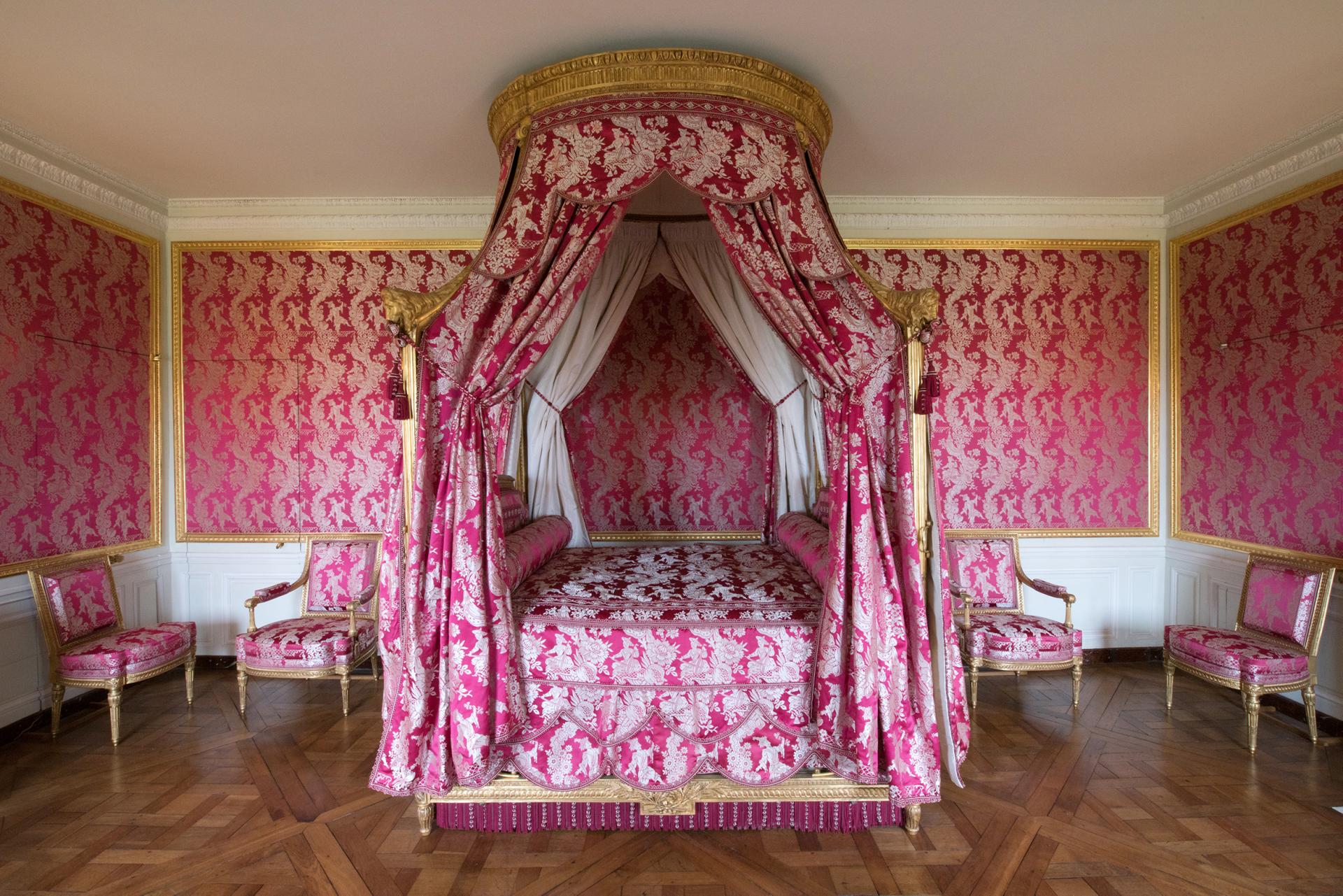
King’s Bedchamber
© THOMAS GARNIER
Louis XVI, who would come to spend the day or have supper at Trianon, kept the décor chosen by his ancestor Louis XV for this room, although he preferred to sleep at the Palace. To date, however, none of the original furniture items has been able to be identified.
The gilded beech, Polish-style (canopy) bed, dating from around 1775, featuring posts with sculpted lion heads, replaces the Turkish-style one known to have been made by Nicolas-Quinibert Foliot. This bed resembles the one slept in by Louis XV and was kept by Louis XVI, then used by his sister, Madame Élisabeth. Like the walls and the furniture, it is covered in crimson and white lampas silk bearing a “Chinese music” pattern, which was able to be rewoven in Lyon based on the inventory taken in 1769.
This room was occupied in the 19th century by Prince Camille Borghese, the husband of Pauline Bonaparte, Napoleon’s sister, and then by the Duke of Orleans.
The King’s Private Chamber
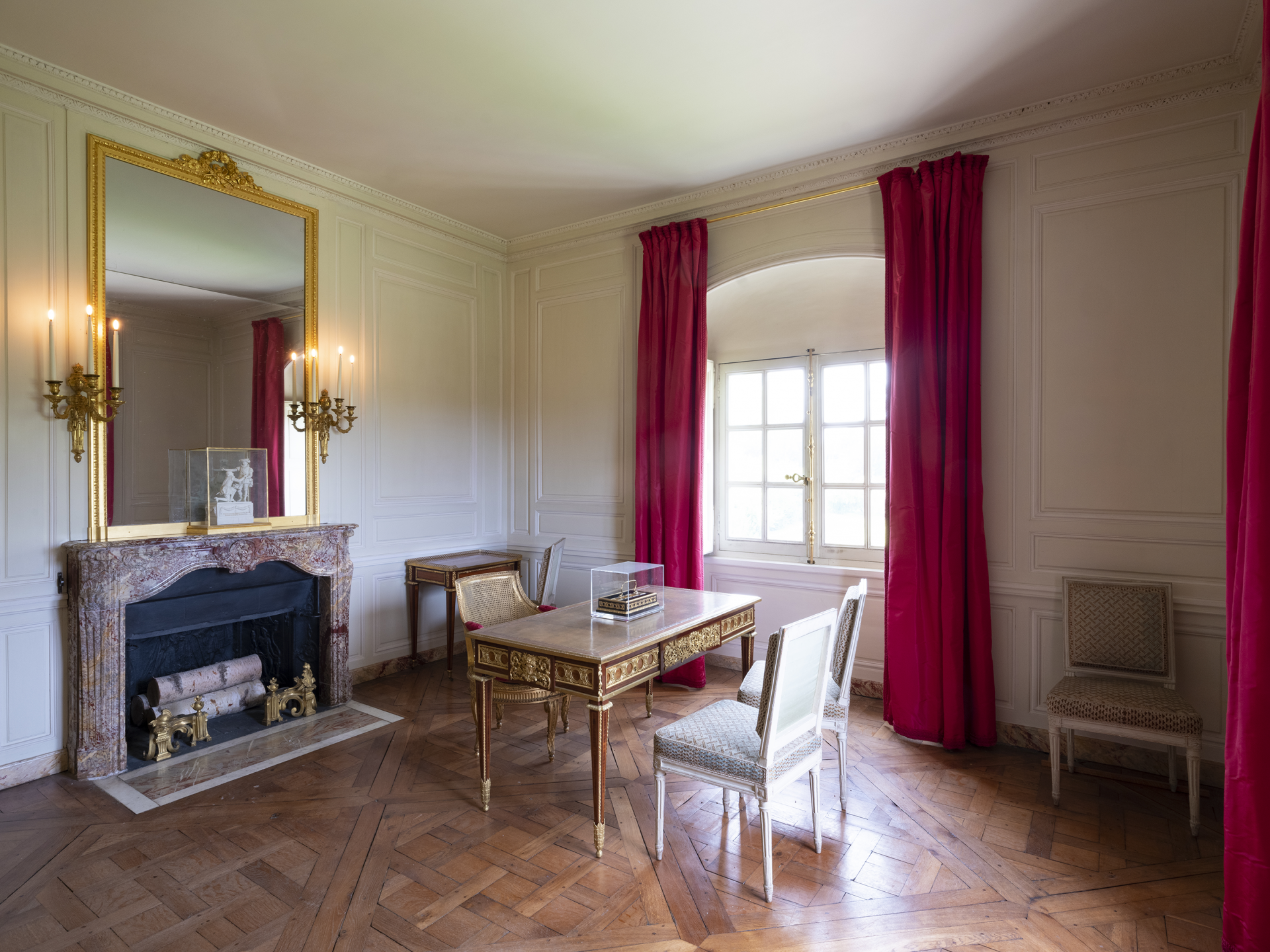
King’s Private Chamber
© THOMAS GARNIER
Located at the top of the staircase that, before it was removed, led to where Madame Du Barry resided, this chamber – the final room in the king’s apartment – is the only space to have been refurbished by Louis XVI, in 1777.
Although the sovereign kept almost all of the furniture items chosen by Louis XV, he nevertheless ordered some special furnishings for his private chamber. These include, in particular, the chest of drawers by Jean Henri Riesener. This magnificent piece of satinwood and amaranth marquetry and gilded bronze, with a white veined marble top, came back into the Palace of Versailles collections in 1981. Its edging of bronze and egg-and-dart motifs perfectly matches that of the flat writing desk, whose ebony and gilded-bronze writing surface bears the mark of the Queen’s Furniture Repository and of Trianon.
Madame Elisabeth’s bedroom

Madame Elisabeth’s bedroom
© THOMAS GARNIER
The first room after the king’s apartment is dedicated to Élisabeth Philippine Marie Hélène, known as Madame Élisabeth, sister of Louis XVI, who stayed there in place of her brother.
The décor in this room has a floral theme, as epitomised by the printed cotton fabric wallcoverings, which feature Jouy manufactory patterns from the 1780s.
A portrait of Madame Élisabeth, attributed to Élisabeth Vigée-Lebrun, came to Trianon during Louis-Philippe’s reign and hangs on the wall of this room. On top of the grey-veined marble fireplace sits a painted marble and gilded-bronze pyramidal pendulum clock, with movement by Louis Bausse and dial by Joseph Coteau.
Madame Royale’s bedroom
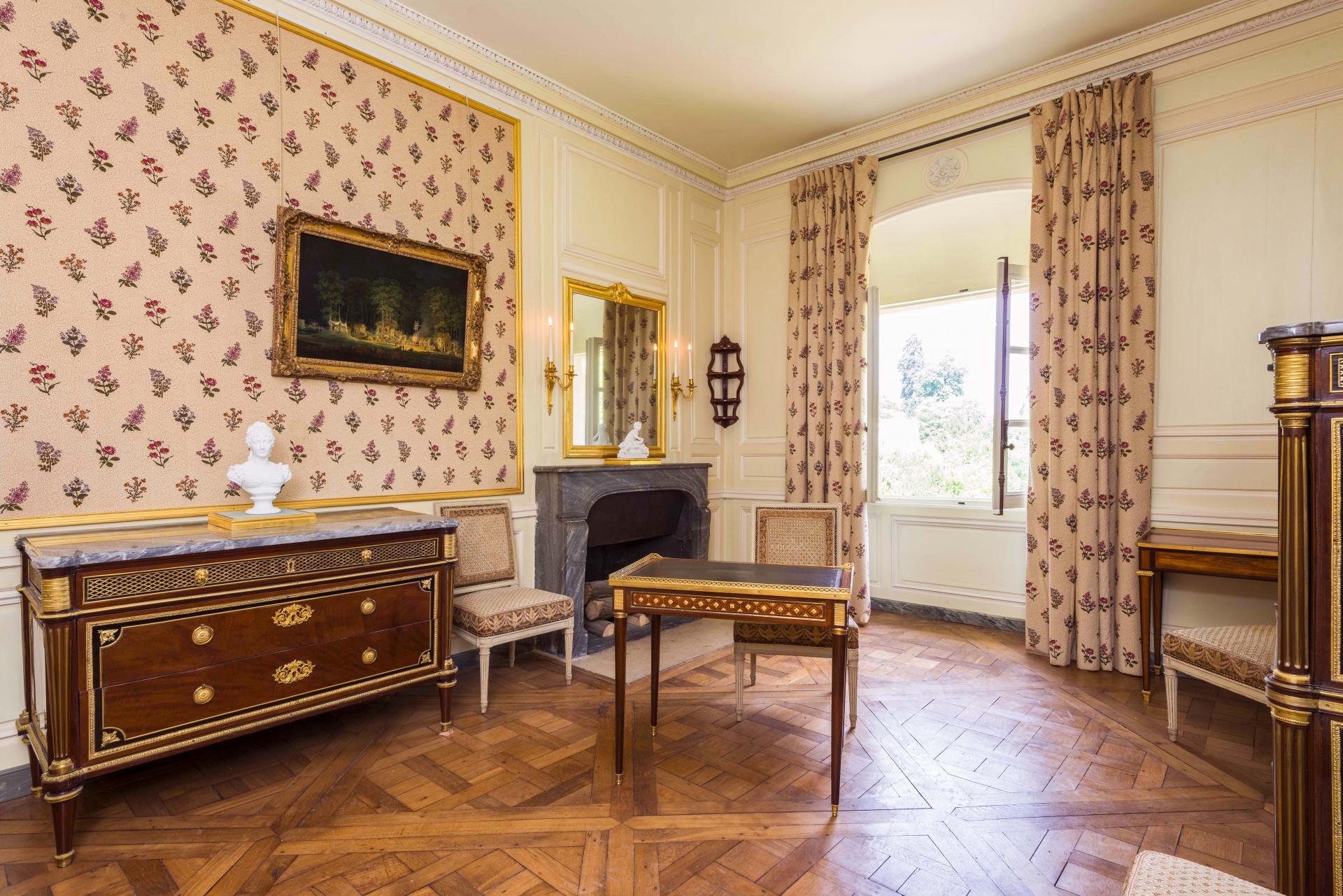
Madame Royale’s bedroom
© CHRISTOPHE FOUIN
This second bedroom, with its simple, moulded wood panelling and fireplace of painted stone and fake marble, is designed to look like the bedroom of Marie Thérèse Charlotte, known as Madame Royale, daughter of Louis XVI and Marie-Antoinette, who resided on this floor.
Marie-Antoinette had this apartment converted for her four-year-old daughter in 1782, as it was close to that of her aunt and governess, the Duchess of Polignac.
As in the previous room, the wallcoverings reproduce the fabrics printed by the Jouy manufactory in the 1780s. The mahogany and gilded-bronze chest of drawers and desk are by Jean-Jacques Pafrat and come from the Château du Raincy, where they were seized during the French Revolution.
On top of the chest of drawers is a bust made of biscuit de Sèvres porcelain dating from around 1820. It is of Madame Royale, who became the Duchess of Angoulême upon her marriage to her German cousin (son of Charles X).
The Empress Marie Louise’s Toilette Room
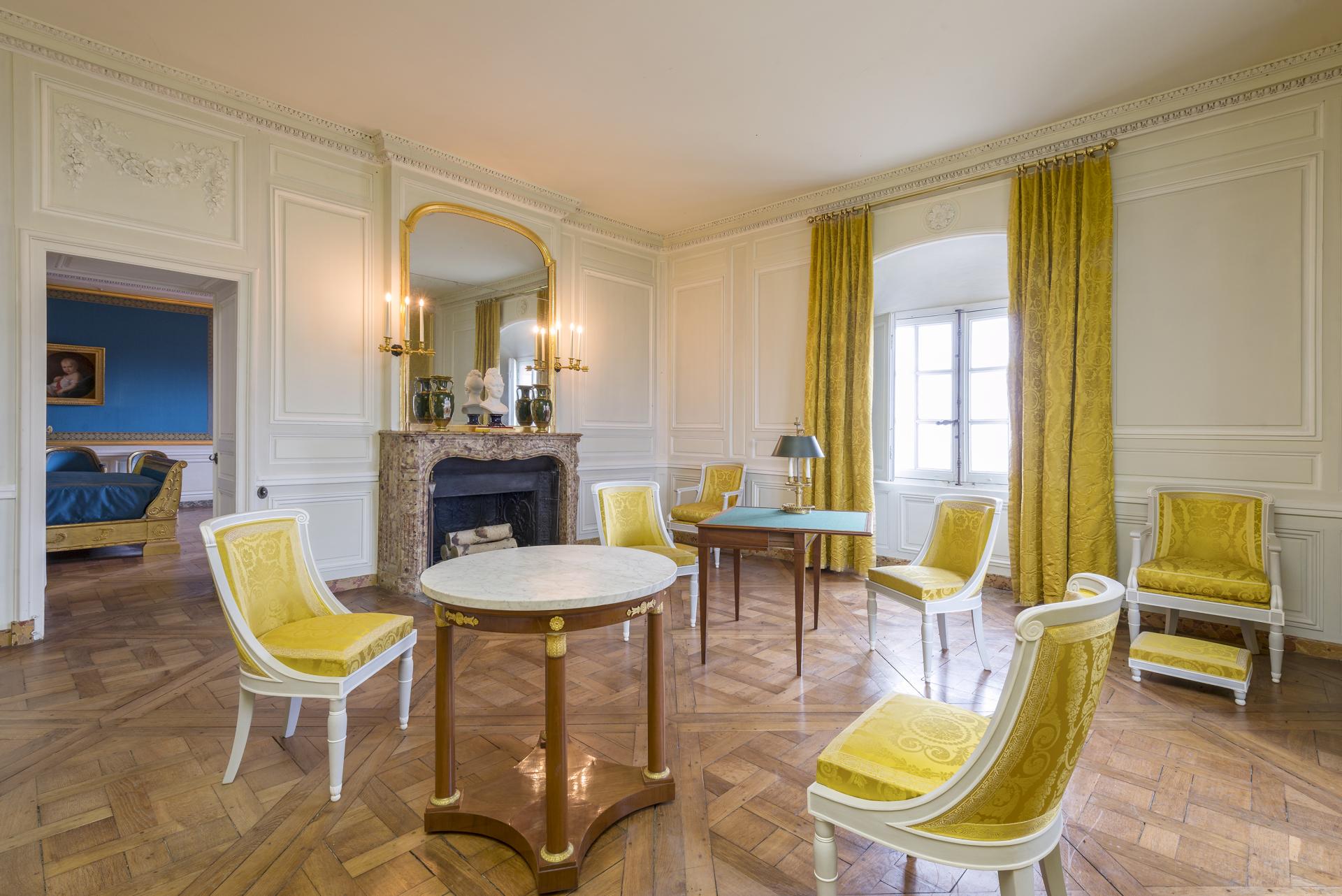
Empress Marie Louise’s Toilette Room
© CHRISTOPHE FOUIN
One part of the attic – probably where Madame Royale resided – has recently been redesigned to recall the other women whose history is linked with that of the Petit Trianon. Marie-Antoinette had converted the two middle apartments into one bigger room overlooking the French Gardens. Today, this room houses the furniture provided for the Empress Marie Louise, whose bedroom was on the floor below. The gondola-shaped furniture, supplied by Darrac – the upholsterer of the Imperial Furniture Repository – was originally covered in a Jouy fabric featuring a medallion pattern on a green background and delivered in 1811. This was replaced in 1837 by a yellow silk damask reproduced according to the archives. On the fireplace, the bust in biscuit de Sèvres porcelain of the Empress Marie Louise is a modern version sent by Sèvres to Versailles in 1962 and inspired by the bust created in 1813 by Nicolas Delaistre.
The Empress Marie Louise’s Bedroom
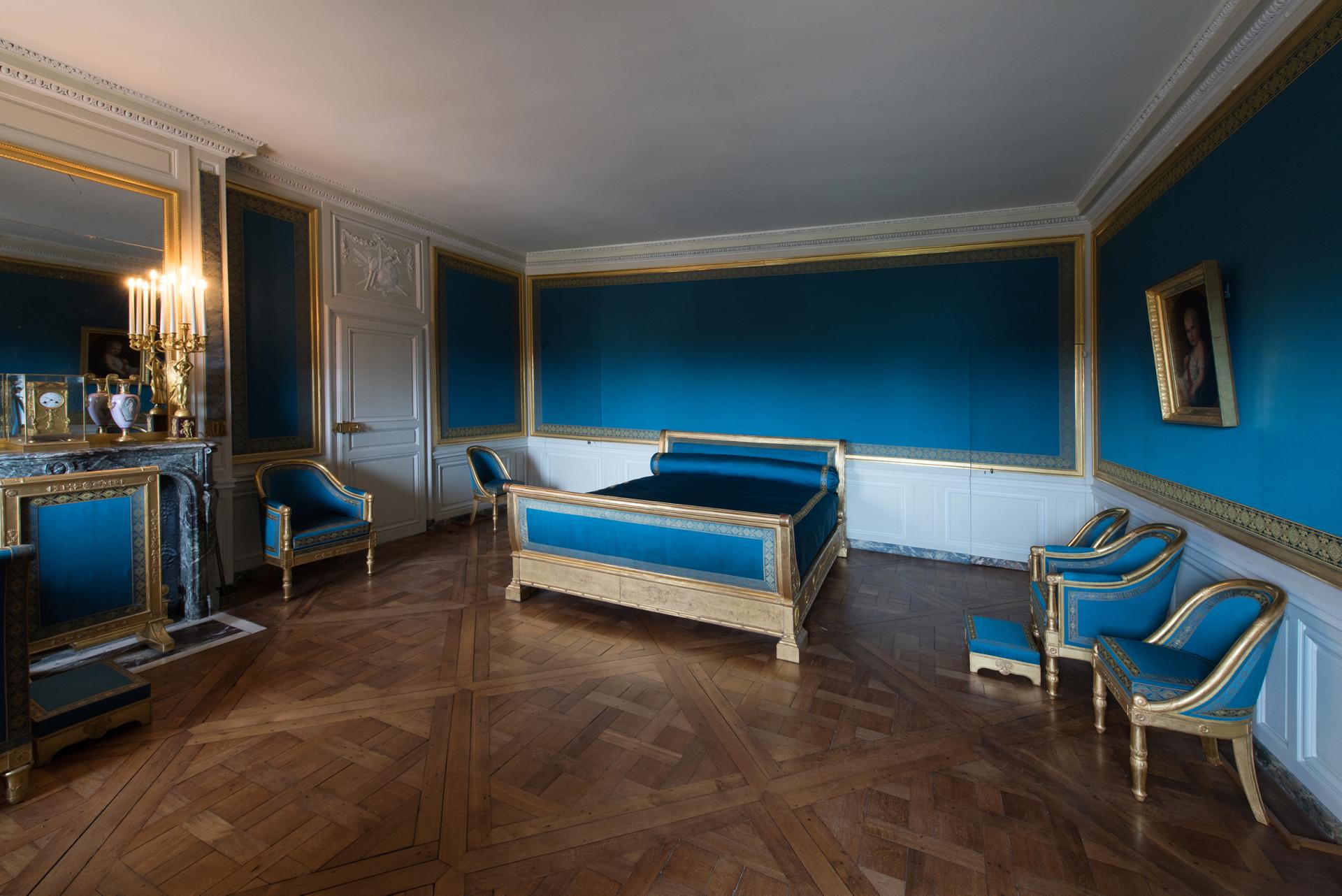
Empress Marie Louise’s Bedroom
© THOMAS GARNIER
The Duchess of Orleans kept the empress’s furniture for her own use, but had the sky-blue satin replaced in 1837 with a cannetillé woven cloth of darker blue. She also replaced the original bed, which was surrounded by curtains, with a more understated one.
On the wall is a portrait of the King of Rome, son of Napoleon and Marie Louise, at barely one year old. In the portrait, painted in 1812 and signed by François Gérard, the infant is already sporting the red ribbon of the Legion of Honour conferred upon him by his father when he was born.
The Duchess of Orleans’ Boudoir
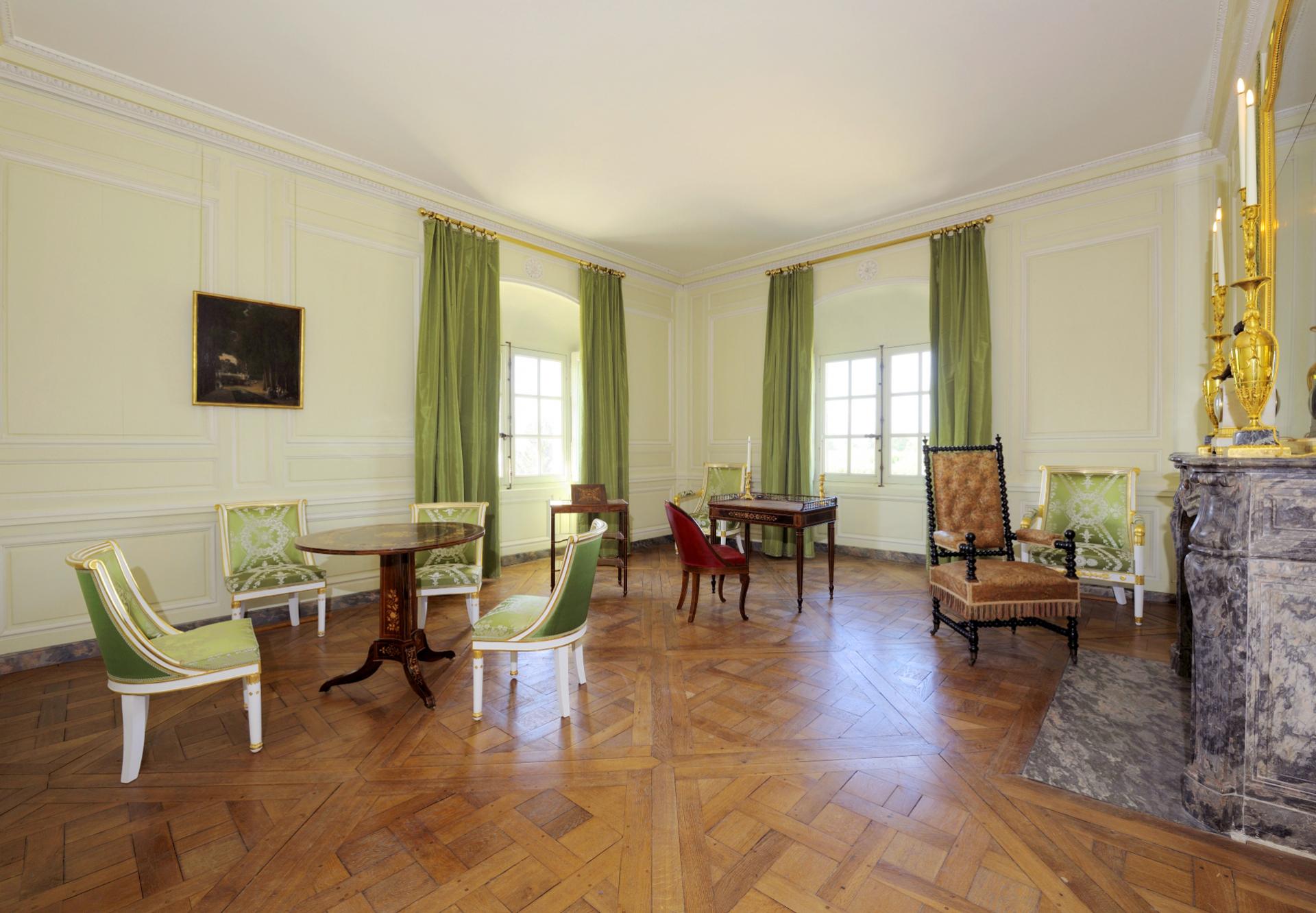
Duchess of Orleans’ Boudoir
© JEAN-MARC MANAÏ
This room is reminiscent of the boudoir of the Duchess of Orleans, Hélène-Louise de Mecklembourg-Schwerin, wife of Louis-Philippe I’s eldest son.
Located in the south-west corner of the attic, this room was furnished with chairs covered in green and white lampas ordered in 1810 by Marie Louise, and then, in 1837, with a lovely set by Louis Edouard Lemarchand comprising a pedestal table, a desk and a table with an inlay design of rosewood and holly.
The Eugénie Room
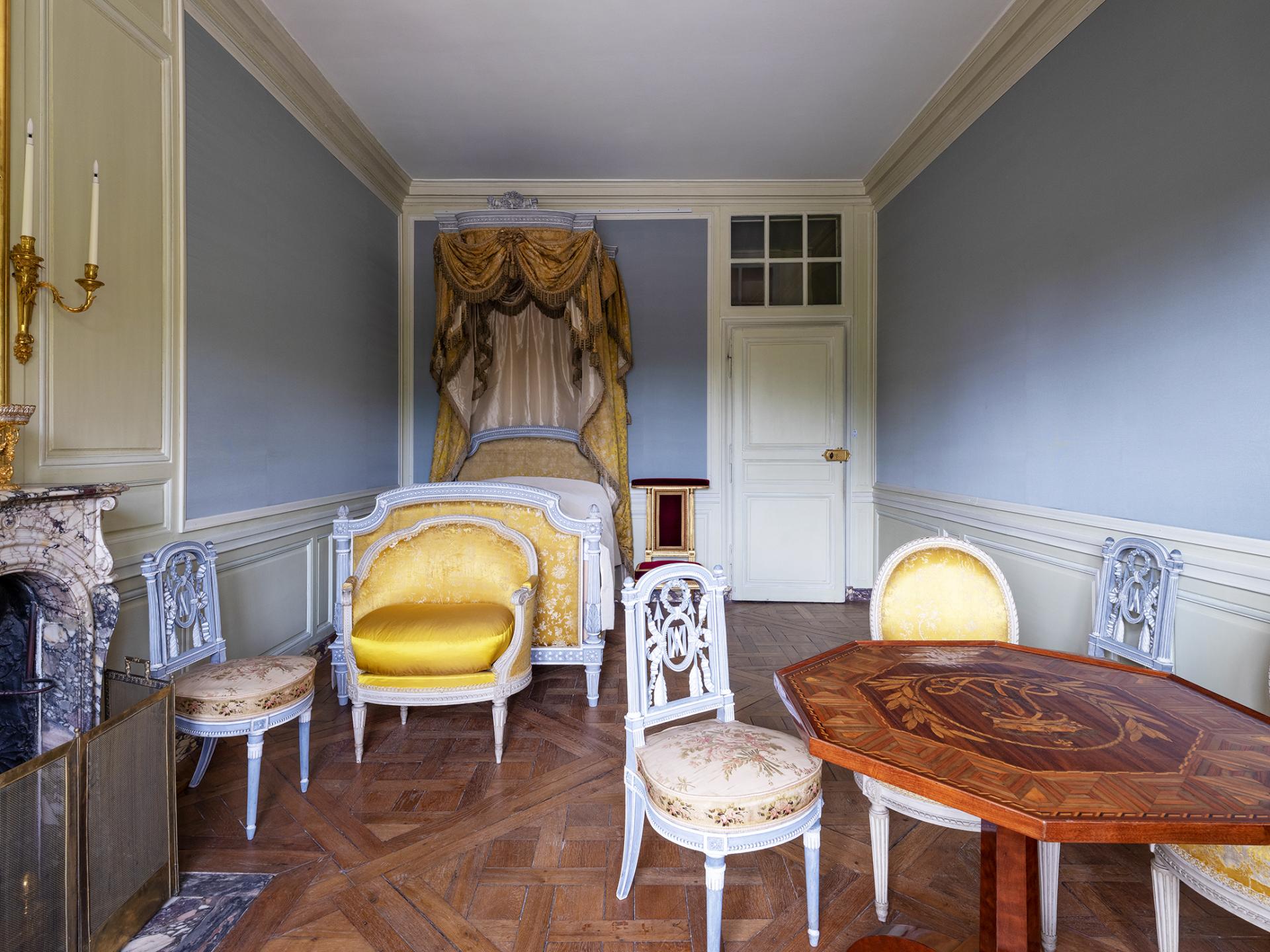
Eugénie Room
© THOMAS GARNIER
The Empress Eugénie, a bust of whom sits on the mantelpiece, always had a real attachment to the memory of Marie-Antoinette. It was she who, during the Second Empire, decided to restore the Petit Trianon, where she gathered together a number of objects that had belonged to the queen and which she displayed to the public in 1867. Today, this part of the attic preserves the memory of that set-up and displays a set of furniture that the empress had placed in the queen’s bedroom on the first floor.
Focus:
The Restoration-era pedestal table with tilting top, made from mahogany and satinwood marquetry, holly, rosewood and stained sycamore, features – at its centre – the monograms of King Louis XVI and Queen Marie-Antoinette. It is surrounded by four chairs by Jean-Baptiste Demay bearing Marie-Antoinette’s monogram, which were also placed in the Petit Trianon in 1867.
Tour leaflet
The tour leaflet is available for free at the entrance.
Suggested tour routes
You can also find suggested tour routes around the Estate of Trianon on the official Palace of Versailles app.
Buy your ticket
Guided tour
To find out more
In 1781, Queen Marie-Antoinette had a series of albums of watercolours created, which were intended for her loved ones and her own use. Produced under the supervision of the architect Richard Mique, the watercolours comprise plans, elevations and picturesque views of the estate of the Petit Trianon.
In 2016, the Palace of Versailles acquired this album, which Marie-Antoinette kept in her own library. Depicting the Love Monument, the Belvedere, the Grotto, the Chinese Ring Game and the Queen’s Theatre, the album reveals to us what the Trianon was like in the late 18th century.
Today, this album is classed as a national treasure.





